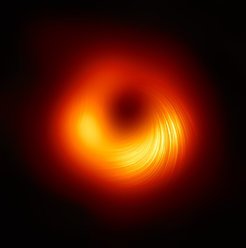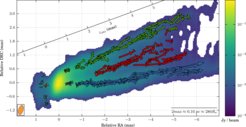M2FINDERS - Research areas
The M2FINDERS project will be realised in three main steps.
Magnetic field measurements

Our first goal is to do polarimetric imaging of the immediate vicinity of the black hole. To reach the highest possible resolutions we will focus on global VLBI observations at 22 and 43GHz, with GMVA at 86GHz and with the EHT at 240GHz. This study will enable us to determine the magnetic field structure from measuring the linear polarisation and Farady rotation. In order to also obtain the strength of the magnetic field properties of the AGN jets over multiple-frequencies and their time-evolution will be analyzed. The main methods will focus on obtaining the turnover frequency of the synchrotron spectrum and measuring the core-shift at different frequencies.
Interferometric techniques development

To obtain the measurements of the magnetic field requires an improvement of the polarisation accuracy of VLBI arrays. Building on the ongoing ALMA phasing project we will improve the polarisatoin calibration. This includes advancements in hardware and software for broad-band recording as well as developement of new imaging routines and enhancements in wavelet image deconvolution.
Furthermore, the source-frequency phase referencing mode will be made available for the Effelsberg 100-m telescope at 22/43/86 GHz. Through joint observations with the KVN and the Yebes telescope we we will apply the source-frequency phase referencing technique implemented at the KVN, in order to measure core shifts with high accuracy.
Development of analysing methods
This working area focuses on two main goals to develop the framework required to obtain the most accurate measurements of the magnetic field and to improve the physical interpretation of the outcomes.
The first part will focus on the development on the techniques required for the reconstruction of the magnetic field: methods for turnover frequency imaging and deriving the 3D distribution of the magnetic field structure. This will be obtained by combining the imaging of polarised emission, Faraday rotation measure, and the synchrotron turnover frequency and flux density. As a result a full 3D structure of the magnetic field will be made, allowing us to distinguish between the structural morphologies inherent to the disk/jet-dominated field and the central rotator-dominated field.
The second part will yield a method for making the most accurate and robust estimate of the magnetic field strength. We will build a model which incorporates the jet collimation profile and the acceleration of the jet plasma. This model will be applied to the long-term core shift variability data in order to assess possible biases introduced in the magnetic field estimates by, e.g., flaring acrivity in the target objects.

